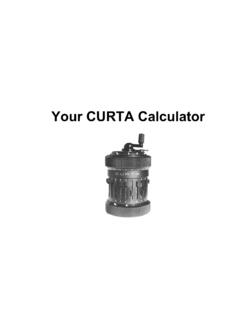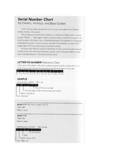Transcription of When was your Curta made - The Curta Calculator
1 when was your Curta made ? Formulae for calculating when a particular serial number Curta Calculator was made have been published on the web, particularly on Rick Furr s excellent site ( ). However those I ve seen seem to assume a constant rate of manufacturing calculators, a scenario extremely unlikely, and indeed contradicted by other information on Rick s site ( Facts from Rick ) stating: In 1949, only 300-400 Curtas were made each month. By 1952, 1,000 Curtas were made each month The source of these numbers is not given, but I m going to use them as if they re gospel . Other pertinent facts (again from Rick s site, with minor edits) are: Curta I s were produced from 1947 to 1970.
2 Curta II s were produced from 1954 to 1970. The last Curta was made in November 1970 There are ~ 80000 Curta I and ~ 70000 Curta II machines. The consensus from various websites seems to be that the number of Type 1 s manufactured was about 78,000 and about 70,000 for Type 2 s, so they re the figures I m running with. I m going to assume that the production rate in 1947 was zero, and start counting from 1948. Likewise I m taking as gospel that production finished in 1970, so the rate for 1971 is zero. Crunching these overall numbers produced, we get an average production rate for Type 1 of 3,391 units per year (for 23 years), and for Type 2 an average rate of 4,118 units per year (for 17 years). So what am I doing differently from the constant rate exponents?
3 I m going to assume that the overall production rate increased linearly from start of production until a peak was reached, then declined steadily (linearly) from then until cessation of production in 1970. Furthermore, I m going to assume that when the Type 2 was introduced, the existing production line capacity was initially split between the two models ( the total manufacturing rate did not increase). Note carefully my use of the word assume in the previous paragraph! This whole issue of calculating a manufacturing year from a serial number is based on big assumptions! I really have no idea of how the manufacturing rate changed over the years (does anyone have Contina s annual production accounts?)
4 ?). All I m doing is taking the scant and imprecise Curta information bandied about and extrapolating it (dangerously!) according to how I might have made manufacturing decisions had I been Contina s Manufacturing Manager at the time! In the real world production rates very rarely change in a linear fashion. In the pre-automation world, rates were typically increased by either adding workers to an existing production line, or adding a whole new line (with many new workers). In either case the increase is a step (small or large), and both the period between such steps and their size are rarely regular. But what can I do in the absence of Contina s accounts assume,smooth and extrapolate!
5 So here s my approach to the when was your Curta made ? Page 2 of 3 In order to visualise my assumptions, I ve plotted them in a rough graph (above). Why has the production rate in 1952 been specifically mentioned in Rick s notes? Could it be that this was the year with the highest production rate throughout the history of Curta manufacture? I m going to assume so, and thus my point a in the graph above shows this peak annual production rate. From there I assume the total production rate declines steadily until point e (in 1970) when production ceases completely. The other known point marked is 4800 units per year (400/month) in 1949. In 1954 I ve assumed (as mentioned earlier) that existing production capacity was split between the two models, so Type 1 drops to d and Type 2 starts at c per annum.
6 From there I ve assumed Type 1 production rate changes linearly till it reaches zero in 1971 [ 1970 is the last year with non-zero production rate, viz. g ] (the majority of Type 1 s [somewhat over 47,000] would have been produced before 1954, based on the above graph, so the rate for the much longer production period after that has to be pretty low), while the Type 2 rate also changes linearly to f in 1970, when all production stops. Looking at the shape of the total (Type 1 + Type 2) production rate (above), it seems sort of Production ramps up quickly during the first several years, as the product becomes known and appreciated around the world, then as the market nears saturation the growth rate declines to match ongoing replacement and new sales.
7 In 1967 the first electronic pocket Calculator was released (by Texas Instruments, I believe), but Contina may not have noticed its impact for a few more years, when they saw the writing on the wall and stopped production. By this time a considerable inventory had probably been built up (presumably due to rapidly declining sales because of the electronic competition), which reputedly took some further three years (to about 1973) to be largely sold off. Sounds reasonable, doesn t it? But remember, it s all purely hypothetical!We know the value of a (12,000), so all we need to do now is calculate c , d , f and g . I m not going to bore you with the maths (you re sick of school algebra, right?)
8 , but the answers come out as, c = 7,383, d = 3,401, f = 852 and g = 201 (b = 10,784 and e = 1053). As well as these end-points, slopes of the various straight-line segments have been calculated, and used to produce a formula for each straight-line segment, so the (hypothetical) production rate for any given year can be calculated. OK, so how do I calculate my machine s year of manufacture? you ask. Well, all we have to do is integrate the above graphs to find the cumulative units produced, and we re almost there. Uh oh, differential calculus not your strongest subject at high school? Mine neither, but we ll muddle through it somehow. 1948194919501951195219531954195519561957 1958195919601961196219631964196519661967 1968196919702000 Unitsmadeperyear4000600080001000012000 Type1 Type2 TotalCurta Calculators manufacturing rate by year (hypothetical!)
9 Abcd480012000eType119471971fgWhen was your Curta made ? Page 3 of 3 In fact we ll just do a simple numerical integration, using the production rate for each year as an average for that whole year, and adding the number of units corresponding to each year s rate. By entering the derived formulae into an Excel spreadsheet, the rest of the number -crunching is done for us. The resulting numbers are shown in the following table (pasted from the Excel spreadsheet). Keep in mind the Type 1 ( T1 ) serial numbers started at 1 , while the Type 2 ( T2 ) serial numbers started at 500,000. T1 S/N EOY means Type 1 serial number at end-of-year , etc. So, to find your Calculator s (hypothetical!) year of manufacture, look down the appropriate Tx S/N EOY column until you find the first year with a S/N equal to or larger than yours, and the year in the left-most column of that row is your manufacturing year.
10 Maybe (give or take a few years)! Incidentally, the reason the total numbers made (for Type 1 and 2) don t come out as exactly 78,000 and 70,000 (my starting assumptions) is due to my numerical rounding of the slopes and end-points of the straight-line segments. To try to refine this method to determine a month of manufacture (as some people do!) is patently ludicrous, give the huge assumptions and approximations made in developing these figures. Consider yourself lucky if you find out your manufacturing year to within a few years! Is it important anyway? YearT1/yearT2/yearT1 totalT2 totalGrand totalT1 S/N EOYT2 S/N EOY19482400 0 2400 0 2400 240019494800 0 7200 0 7200 720019507200 0 14400 0 14400 1440019519600 0 24000 0 24000 24000195212000 0 36000 0 36000 36000195311392 0 47392 0 47392 4739219543401 7383 50793 7383 58176 50793 50738319553201 6975 53994 14358 68352 53994 51435819563001 6567 56995 20924 77919 56995 52092419572801 6158 59796 27083 86879 59796 52708319582601 5750 62397 32833






